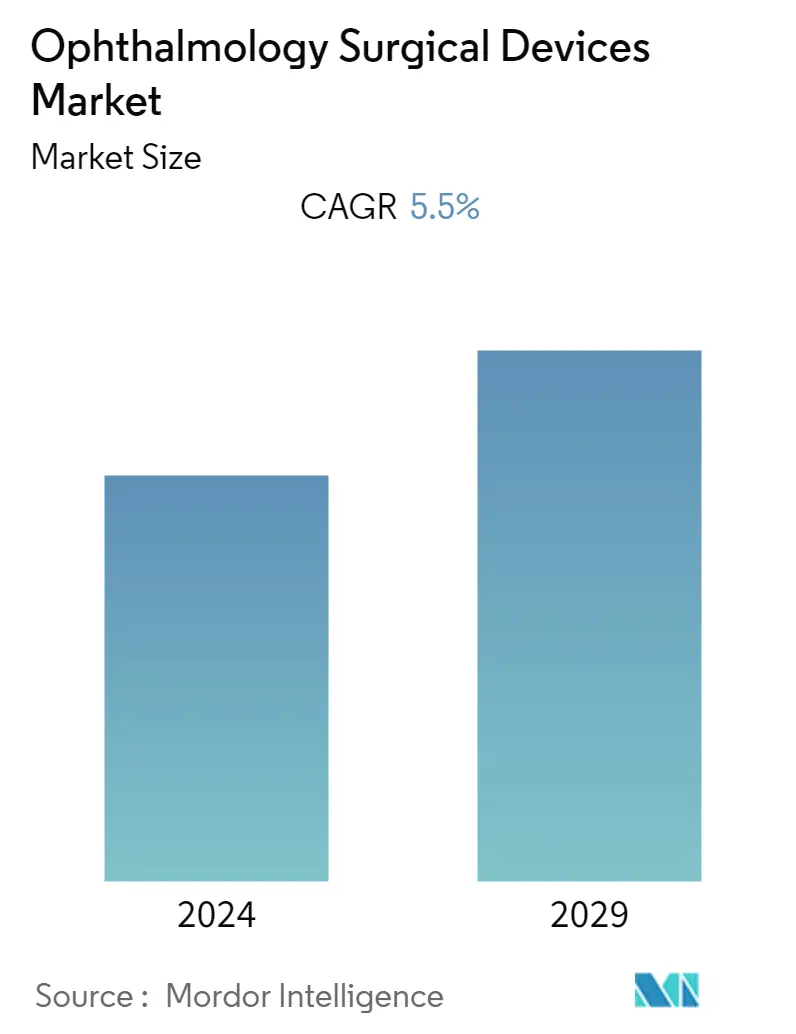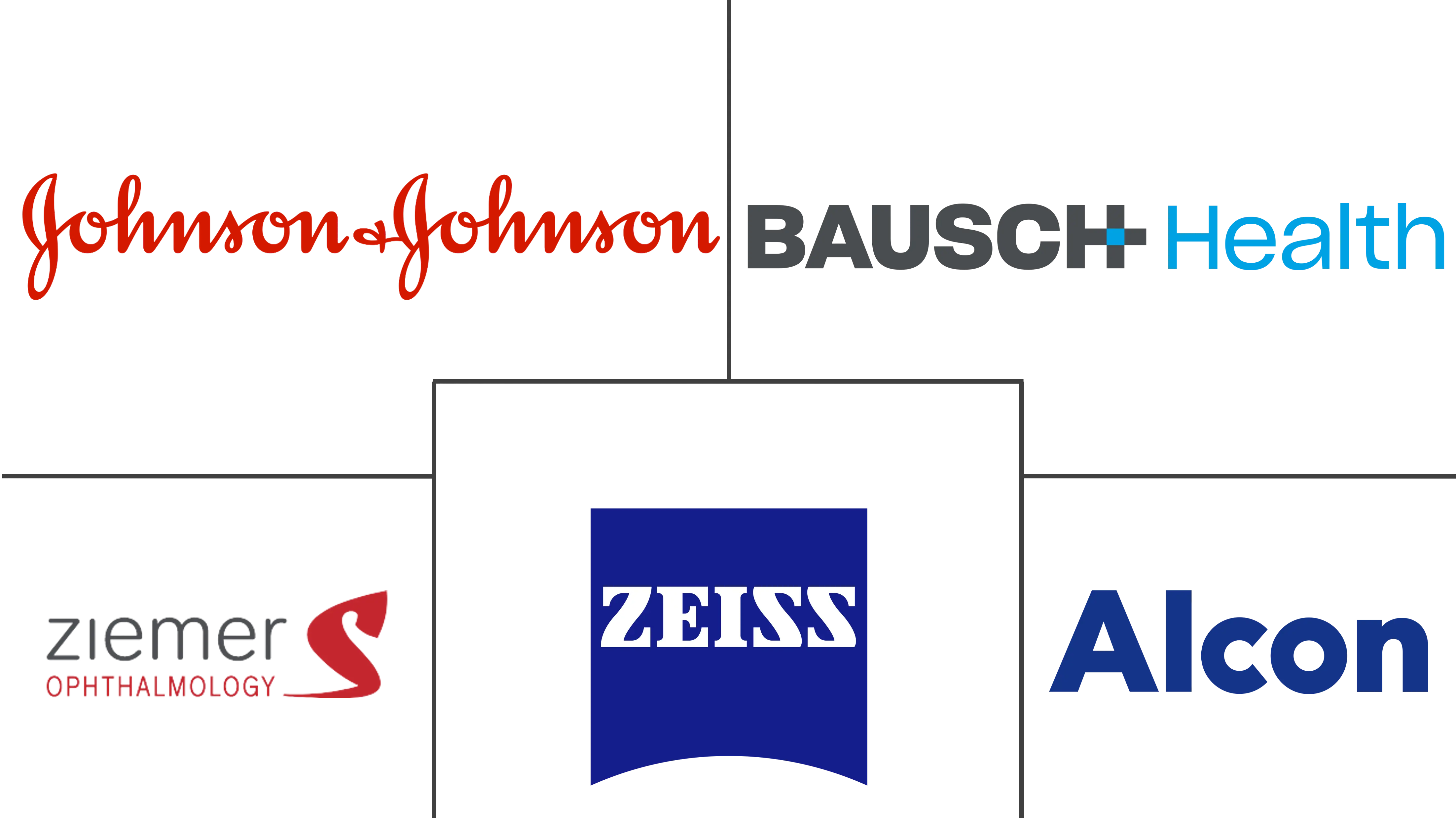Market Size of Ophthalmology Surgical Devices Industry

| Study Period | 2019 - 2029 |
| Base Year For Estimation | 2023 |
| CAGR | 5.50 % |
| Fastest Growing Market | Asia Pacific |
| Largest Market | North America |
| Market Concentration | Medium |
Major Players
*Disclaimer: Major Players sorted in no particular order |
Ophthalmology Surgical Devices Market Analysis
The ophthalmology surgical devices market studied is expected to register a CAGR of 5.5% during the forecast period.
- During the initial wave, the COVID-19 pandemic significantly impacted the ophthalmology surgical devices market, as many ophthalmic surgeries and consultations were delayed or canceled due to the global lockdown. This resulted in a substantial backlog of patients developing advanced cataracts and other eye disorders, significantly affecting the market. However, with the resumption of transport and decreasing cases of COVID-19, the market is expected to recover from the decline over the forecast period, mainly due to the increasing demand for ophthalmic surgeries worldwide.
- The global prevalence of ophthalmic disorders such as glaucoma, cataract, and diabetic retinopathy primarily drives the market growth. The rise in the geriatric population results in the global burden of avoidable blindness. For example, according to the December 2022 update by the Centers for Disease Control and Prevention, vision impairment in the United States affects around 12 million people aged 40 years or above. This includes approximately 1 million who are blind and 3 million who have vision impairment even after correction. Similarly, according to the 2021 update by Macular Disease Foundation Australia, glaucoma prevalence among Australians is predicted to increase to 379,000 by 2025.
- The market growth is also fueled by advanced technologies in ophthalmology surgery devices and virtual reality options. Alcon, for instance, introduced its new Alcon Fidelis Virtual Reality (VR) Ophthalmic Surgical Simulator, a portable VR tool for cataract surgeons-in-training, which offers a high-fidelity, virtual operating room environment with haptic feedback to simulate the look and feel of cataract surgery.
- Additionally, government initiatives and support for the visually impaired population are likely to increase awareness and thereby drive market growth over the forecast period. For example, the Foundation Fighting Blindness launched a new social media campaign, #ShareYourVision, and WHO launched a new guide on eye care, Eye Care in Health Systems: Guide for Action, providing practical, step-by-step guidance to support Member States in planning and implementing integrated, people-centered eye care services.
- Despite these factors, the high cost of the devices and unfavorable reimbursement policies are likely to restrain the market growth. Nonetheless, due to the rise in eye diseases, increasing product launches, technological advancements, and government initiatives, the ophthalmology surgical devices market is expected to witness significant growth over the forecast period.
Ophthalmology Surgical Devices Industry Segmentation
As per the scope of the report, ophthalmology surgical devices are used in retinal, refractive, and cataract surgeries, diagnosis, and in treatment of various ophthalmic diseases such as cataract, glaucoma, and refractive error. These devices are employed majorly when the disease is not diagnosed at an early stage.
The ophthalmology surgical devices market is segmented by product (cataract surgery devices, glaucoma surgery devices, refractive surgery devices, and other surgical devices), end-user (hospitals, specialty clinics, ambulatory surgical centers), and geography (North America, Europe, Asia-Pacific, Middle East, and Africa, South America). The report also covers the estimated market sizes and trends for 17 countries across major regions globally.
The report offers the value (in USD) for the above segments.
| By Product | |
| Refractive Surgery Devices | |
| Glaucoma Surgery Devices | |
| Cataract Surgery Devices | |
| Other Surgical Devices |
| By End-User | |
| Hospitals | |
| Speciality Clinics | |
| Ambulatory Surgical Centers |
| Geography | ||||||||
| ||||||||
| ||||||||
| ||||||||
| ||||||||
|
Ophthalmology Surgical Devices Market Size Summary
The ophthalmology surgical devices market is poised for significant growth, driven by the increasing prevalence of ophthalmic disorders such as glaucoma, cataracts, and diabetic retinopathy. The market's recovery from the initial setbacks caused by the COVID-19 pandemic is expected to be bolstered by the rising demand for ophthalmic surgeries globally. The geriatric population's expansion further contributes to the market's growth, as it increases the burden of avoidable blindness. Technological advancements, such as Alcon's introduction of virtual reality tools for cataract surgery training, and government initiatives aimed at supporting the visually impaired, are also key factors propelling the market forward. Despite challenges like high device costs and unfavorable reimbursement policies, the market is anticipated to witness robust growth due to these driving forces.
The cataract surgery devices segment is expected to capture a substantial share of the market, fueled by the rising number of cataract cases and ongoing technological innovations. Government campaigns, such as those in India to address cataract surgery backlogs, are creating a favorable environment for market expansion. North America is projected to maintain a significant market share, supported by the increasing prevalence of eye diseases, technological advancements, and strategic efforts by market players like Alcon and Johnson & Johnson. The competitive landscape is characterized by major players developing new products and forming partnerships to enhance their global market position. Overall, the ophthalmology surgical devices market is set for considerable growth, driven by a combination of technological advancements, government support, and increasing demand for surgical interventions.
Ophthalmology Surgical Devices Market Size - Table of Contents
-
1. MARKET DYNAMICS
-
1.1 Market Overview
-
1.2 Market Drivers
-
1.2.1 Increase in Burden of Ophthalmic Diseases
-
1.2.2 Rise in Government Support to Control Visual Impairment and Rapid Advancements in the Ophthalmic Industry
-
-
1.3 Market Restraints
-
1.3.1 Higher Cost of the Ophthalmology Surgical Devices
-
1.3.2 Unfavorable Reimbursement Policies Pertaining to the Ophthalmic Surgery Industry
-
-
1.4 Porter's Five Forces Analysis
-
1.4.1 Threat of New Entrants
-
1.4.2 Bargaining Power of Buyers/Consumers
-
1.4.3 Bargaining Power of Suppliers
-
1.4.4 Threat of Substitute Products
-
1.4.5 Intensity of Competitive Rivalry
-
-
-
2. MARKET SEGMENTATION (Market Size by Value - USD)
-
2.1 By Product
-
2.1.1 Refractive Surgery Devices
-
2.1.2 Glaucoma Surgery Devices
-
2.1.3 Cataract Surgery Devices
-
2.1.4 Other Surgical Devices
-
-
2.2 By End-User
-
2.2.1 Hospitals
-
2.2.2 Speciality Clinics
-
2.2.3 Ambulatory Surgical Centers
-
-
2.3 Geography
-
2.3.1 North America
-
2.3.1.1 United states
-
2.3.1.2 Canada
-
2.3.1.3 Mexico
-
-
2.3.2 Europe
-
2.3.2.1 France
-
2.3.2.2 Germany
-
2.3.2.3 United Kingdom
-
2.3.2.4 Italy
-
2.3.2.5 Spain
-
2.3.2.6 Rest of Europe
-
-
2.3.3 Asia-Pacific
-
2.3.3.1 China
-
2.3.3.2 Japan
-
2.3.3.3 India
-
2.3.3.4 Australia
-
2.3.3.5 South Korea
-
2.3.3.6 Rest of Asia-Pacific
-
-
2.3.4 Middle East and Africa
-
2.3.4.1 GCC
-
2.3.4.2 South Africa
-
2.3.4.3 Rest of Middle East and Africa
-
-
2.3.5 South America
-
2.3.5.1 Brazil
-
2.3.5.2 Argentina
-
2.3.5.3 Rest of South America
-
-
-
Ophthalmology Surgical Devices Market Size FAQs
What is the current Ophthalmology Surgical Devices Market size?
The Ophthalmology Surgical Devices Market is projected to register a CAGR of 5.5% during the forecast period (2024-2029)
Who are the key players in Ophthalmology Surgical Devices Market?
Johnson & Johnson, Alcon Inc, Ziemer Ophthalmic Systems AG, Bausch Health (Bausch & Lomb Incorporated) and Carl-Zeiss-Stiftung (Carl Zeiss AG) are the major companies operating in the Ophthalmology Surgical Devices Market.

